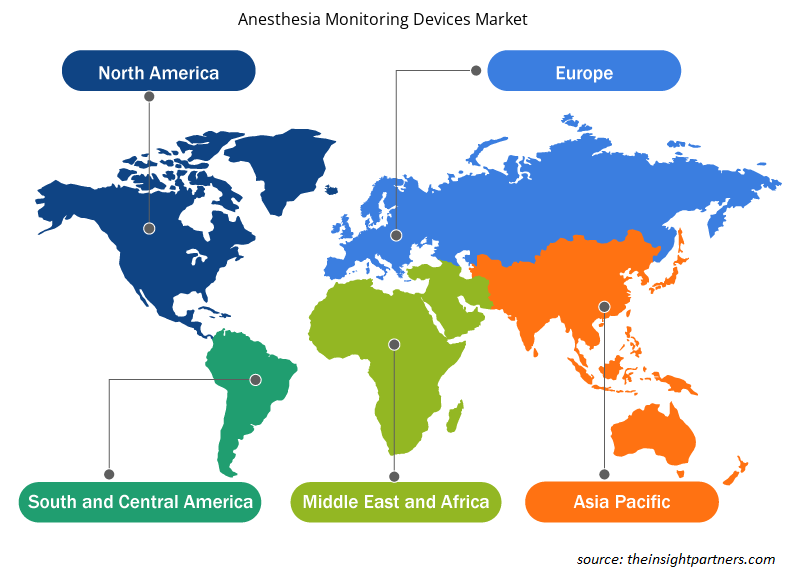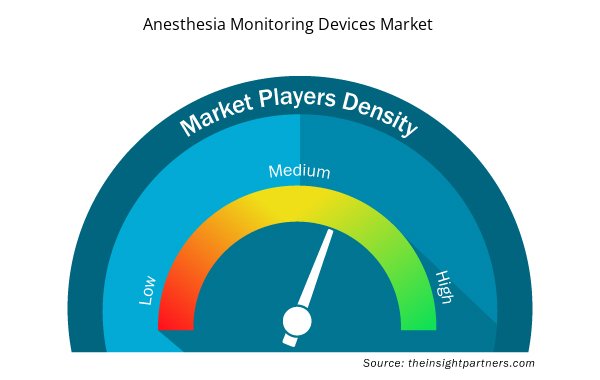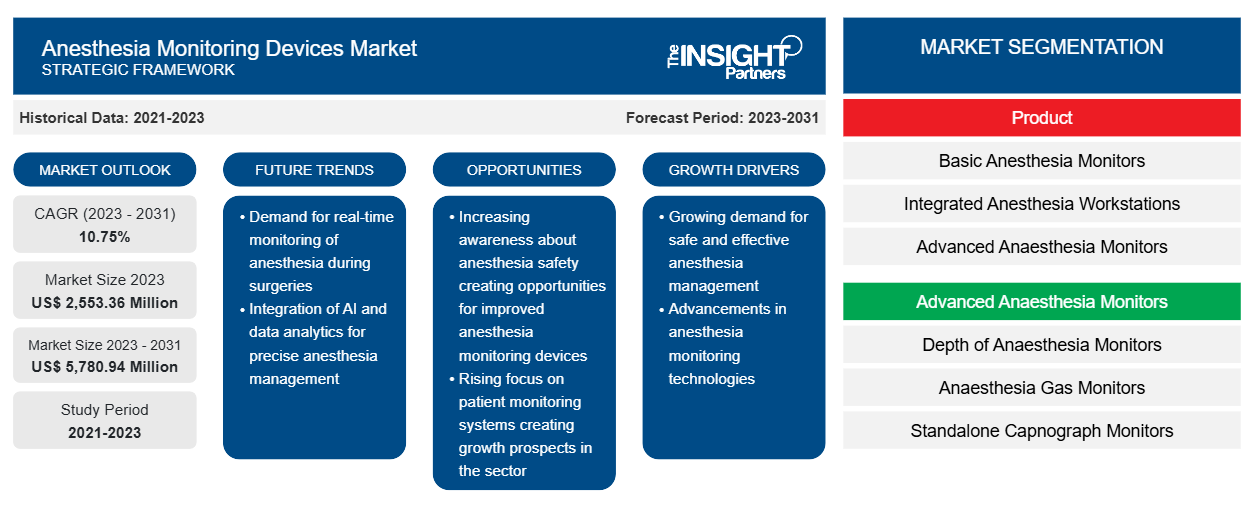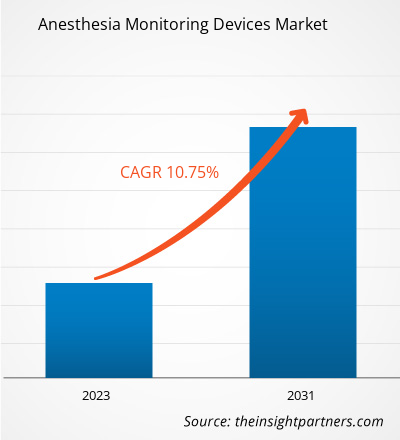[研究报告] 麻醉监测设备市场价值预计将从 2023 年的 25.5336 亿美元增长到 2031 年的 57.8094 亿美元;预计 2023 年至 2031 年的复合年增长率为 10.75%
市场洞察和分析师观点:
在手术过程中,麻醉监测设备会监测患者对麻醉的反应。氧合、循环、呼吸和温度测量可用于跟踪麻醉效果。对麻醉监测设备的需求因情况而异,取决于所进行的手术类型。手术过程中的麻醉管理和监测是一项复杂的技能,需要大量的培训和经验。麻醉监测设备可帮助麻醉师监测麻醉剂量;此外,良好的患者监测可降低麻醉和手术的风险。
推动麻醉监测设备市场增长的关键因素是各种新监测技术的引入,例如麻醉深度监测、目标导向液体治疗、先进的神经系统监测、改进的报警系统以及客观疼痛评估的技术进步。过去几年,临床实践发展和临床监测技术取得了重大进展。麻醉监测设备趋势包括麻醉监测设备的快速数字化。
增长动力和挑战:
手术数量的增加推动了麻醉监测设备市场的发展
手术数量的增加显著影响了麻醉监测设备市场规模,推动了对先进监测技术和解决方案的需求。柳叶刀全球外科委员会 (LCoGS) 强调,全球 28% 至 32% 的疾病负担需要外科护理、麻醉管理或两者兼而有之。报告“全球外科 2030 年实现健康、福利和经济发展的证据和解决方案”表明,全球有 50 亿人在需要时无法获得安全、负担得起的外科和麻醉护理。估计每年有 1690 万人死于外科手术。此外,NCBI 报告称,每年进行 3.1 亿次外科手术,其中欧洲约 2000 万次,美国约 4000 万至 5000 万次。麻醉监测设备可确保患者安全、优化麻醉输送并在整个手术过程中监测生命体征。对患者结果、麻醉管理效率的日益重视以及在手术室采用先进的监测设备是推动市场扩张的关键因素。
另一方面,麻醉监测设备的高成本带来了重大挑战,可能会限制医疗行业的市场增长和采用率。购买先进监测设备以及额外培训、维护和升级所需的初始投资可能会给医疗机构带来财务障碍,尤其是那些在预算或资源受限的情况下运营的机构。麻醉监测设备的高成本可能会给资本支出带来压力,影响投资回报考虑,并可能推迟或阻止医疗保健提供者投资最先进的监测技术。此外,持续的运营成本(例如传感器更换、软件更新和校准服务)会增加总拥有成本,影响医疗机构的购买决策和总体成本效益评估。麻醉监测设备的高成本还可能对医疗基础设施有限、服务不足或经济差距大的地区的市场渗透构成挑战,在这些地区,先进医疗技术的可负担性和可及性仍然是关键考虑因素。因此,这些扫描设备的高成本阻碍了麻醉监测设备市场的增长。
定制此报告以满足您的需求
您可以免费定制任何报告,包括本报告的部分内容、国家级分析、Excel 数据包,以及为初创企业和大学提供优惠和折扣
- 获取此报告的关键市场趋势。这个免费样品将包括数据分析,从市场趋势到估计和预测。
报告细分和范围:
麻醉监测设备市场分析已考虑以下几个部分:基于产品、先进麻醉监测器、技术和最终用户。从地理上看,麻醉监测设备市场分为北美(美国、加拿大和墨西哥)、欧洲(英国、德国、法国、意大利、西班牙和欧洲其他地区)、亚太地区(中国、日本、印度、澳大利亚、韩国和亚太其他地区)、中东和非洲(阿联酋、沙特阿拉伯、南非和中东和非洲其他地区)以及南美洲和中美洲(巴西、阿根廷和南美洲和中美洲其他地区)。
节段分析:
基于产品的洞察
根据产品,市场细分为基础麻醉监测器、集成麻醉工作站和高级麻醉监测器。高级麻醉监测器细分市场在 2023 年占据麻醉监测设备的最大市场份额,预计在 2023-2031 年期间将实现最高复合年增长率。
基于高级麻醉监视器的见解
根据高级麻醉监护仪,麻醉监护设备市场细分为基本麻醉监护仪、综合麻醉工作站和高级麻醉监护仪。预计到 2031 年,麻醉监护仪细分市场将占据相当大的份额。
基于技术的见解
根据技术,市场分为双频指数、听觉诱发电位、患者状态指数、皮质活动状态指数等。双频指数 (BIS) 部分预计到 2031 年将占据相当大的份额。
基于最终用户的洞察
就最终用户而言,市场分为医院、专科诊所和门诊手术中心。就最终用户而言,医院部门在 2023 年占据麻醉监测设备最大的市场份额,预计在 2023-2031 年期间将实现最高的复合年增长率。
麻醉监测设备市场区域洞察
Insight Partners 的分析师已详尽解释了预测期内影响麻醉监测设备市场的区域趋势和因素。本节还讨论了北美、欧洲、亚太地区、中东和非洲以及南美和中美洲的麻醉监测设备市场细分和地理位置。

- 获取麻醉监测设备市场的区域特定数据
麻醉监测设备市场报告范围
| 报告属性 | 细节 |
|---|---|
| 2023 年的市场规模 | 25.5336亿美元 |
| 2031 年市场规模 | 57.8094亿美元 |
| 全球复合年增长率(2023 - 2031) | 10.75% |
| 史料 | 2021-2023 |
| 预测期 | 2023-2031 |
| 涵盖的领域 | 按产品
|
| 覆盖地区和国家 | 北美
|
| 市场领导者和主要公司简介 |
|
麻醉监测设备市场参与者密度:了解其对业务动态的影响
麻醉监测设备市场正在快速增长,这得益于终端用户需求的不断增长,而这些需求又源于消费者偏好的不断变化、技术进步以及对产品优势的认识不断提高等因素。随着需求的增加,企业正在扩大其产品范围,进行创新以满足消费者的需求,并利用新兴趋势,从而进一步推动市场增长。
市场参与者密度是指在特定市场或行业内运营的企业或公司的分布情况。它表明在给定市场空间中,相对于其规模或总市场价值,有多少竞争对手(市场参与者)存在。
在麻醉监测设备市场运营的主要公司有:
- 迈瑞医疗国际有限公司
- 德尔格公司
- 通用电气医疗
- 荷兰皇家飞利浦公司
- 席勒股份公司
免责声明:上面列出的公司没有按照任何特定顺序排列。

- 了解麻醉监测设备市场的主要参与者概况
区域分析:
麻醉监测设备市场报告的范围涵盖北美、欧洲、亚太地区、中东和非洲以及南美和中美洲。2023 年,北美占据麻醉监测设备市场的最大份额,预计在预测期内将保持其主导地位(就份额而言)。美国在北美和世界占有最大的市场份额。该国市场的增长归因于癌症患病率的上升和老年人口的增加。例如,美国癌症协会表示,2021 年美国报告的癌症相关死亡人数约为 608,570 人,新增癌症诊断病例超过 190 万例。此外,预计推动整体业务发展的主要因素包括外科手术数量的增加、技术进步、强大的行业参与者的存在以及对麻醉过程中患者安全的日益关注。其他因素包括人们对远程患者监测设备的认识不断提高,以提高准确性、便携性、连接性和用户友好界面。
竞争格局和重点公司:
本报告中提供的麻醉监测设备市场预测可以帮助该市场的利益相关者制定增长战略。迈瑞医疗国际有限公司、德尔格公司、通用电气医疗集团、荷兰皇家飞利浦公司、席勒公司、Criticare Systems, Inc.、禾珥医疗公司、Infinium Medical, Inc.、Siare Engineering International Group Srl 和日本光电公司是麻醉监测设备市场报告中介绍的几家主要公司。这些公司专注于扩大其产品范围,以满足全球日益增长的消费者需求。他们的全球业务使他们能够为众多客户提供服务,从而扩大其市场占有率。
- 历史分析(2 年)、基准年、预测(7 年)及复合年增长率
- PEST 和 SWOT 分析
- 市场规模价值/数量 - 全球、区域、国家
- 行业和竞争格局
- Excel 数据集


- HVAC Sensors Market
- Mobile Phone Insurance Market
- Non-Emergency Medical Transportation Market
- Surety Market
- Adaptive Traffic Control System Market
- Saudi Arabia Drywall Panels Market
- Microplate Reader Market
- Electronic Signature Software Market
- Single-Use Negative Pressure Wound Therapy Devices Market
- Asset Integrity Management Market

Report Coverage
Revenue forecast, Company Analysis, Industry landscape, Growth factors, and Trends

Segment Covered
This text is related
to segments covered.

Regional Scope
North America, Europe, Asia Pacific, Middle East & Africa, South & Central America

Country Scope
This text is related
to country scope.
常见问题
The key factors driving the anesthesia monitoring devices market growth are the introduction of various new monitoring techniques, such as monitoring the depth of anesthesia, goal-directed fluid therapy, advanced neurological monitoring, improved alarm system, and technological advancements in objective pain assessment. Significant progress has been made in clinical practice development and clinical monitoring technology in the last few years. Anesthesia monitoring devices trends include the rapid digitalization of anesthesia monitoring devices.
The anesthesia monitoring devices market was valued at US$ 2,553.36 million in 2023.
The anesthesia monitoring devices market is expected to be valued at US$ 5,780.94 million in 2031.
The anesthesia monitoring devices market has major market players, including Mindray Medical International Limited; Drägerwerk AG; GE Healthcare; Koninklijke Philips N.V.; Schiller AG; Criticare Systems, Inc.; HEYER Medical AG; Infinium Medical, Inc.; Siare Engineering International Group S.r.l.; and Nihon Kohden Corporation.
Based on product, the market is segmented into basic anesthesia monitors, integrated anesthesia workstations, and advanced anesthesia monitors. The advanced anaesthesia monitors segment held the largest anesthesia monitoring devices market share in 2023 and is anticipated to register the highest CAGR during 2023–2031.
Based on advanced anesthesia monitors, the anesthesia monitoring devices market is segmented into basic anesthesia monitors, integrated anesthesia workstations, and advanced anesthesia monitors. The depth of anaesthesia monitors segment is anticipated to hold a significant share by 2031..
During surgeries, anesthesia monitoring devices monitor the patient's reaction to anesthesia. Oxygenation, circulation, breathing, and temperature measurements can be used to track the effect of anesthesia. The need for anesthesia monitoring devices varies from case to case and is dependent on the kind of surgery being performed. Anesthesia administration and monitoring during surgical procedures is a sophisticated skill that requires much training and experience. Anesthesia monitoring devices assist anesthesiologists in monitoring anesthesia dosage; additionally, good patient monitoring lowers the risks associated with both anesthesia and surgery.
Trends and growth analysis reports related to Life Sciences : READ MORE..
The List of Companies - Anesthesia Monitoring Devices Market
- Mindray Medical International Limited
- Drägerwerk AG
- GE Healthcare
- Koninklijke Philips N.V.
- Schiller AG
- Criticare Systems, Inc.
- HEYER Medical AG
- Infinium Medical, Inc.
- Siare Engineering International Group S.r.l.
- Nihon Kohden Corporation
The Insight Partners performs research in 4 major stages: Data Collection & Secondary Research, Primary Research, Data Analysis and Data Triangulation & Final Review.
- Data Collection and Secondary Research:
As a market research and consulting firm operating from a decade, we have published and advised several client across the globe. First step for any study will start with an assessment of currently available data and insights from existing reports. Further, historical and current market information is collected from Investor Presentations, Annual Reports, SEC Filings, etc., and other information related to company’s performance and market positioning are gathered from Paid Databases (Factiva, Hoovers, and Reuters) and various other publications available in public domain.
Several associations trade associates, technical forums, institutes, societies and organization are accessed to gain technical as well as market related insights through their publications such as research papers, blogs and press releases related to the studies are referred to get cues about the market. Further, white papers, journals, magazines, and other news articles published in last 3 years are scrutinized and analyzed to understand the current market trends.
- Primary Research:
The primarily interview analysis comprise of data obtained from industry participants interview and answers to survey questions gathered by in-house primary team.
For primary research, interviews are conducted with industry experts/CEOs/Marketing Managers/VPs/Subject Matter Experts from both demand and supply side to get a 360-degree view of the market. The primary team conducts several interviews based on the complexity of the markets to understand the various market trends and dynamics which makes research more credible and precise.
A typical research interview fulfils the following functions:
- Provides first-hand information on the market size, market trends, growth trends, competitive landscape, and outlook
- Validates and strengthens in-house secondary research findings
- Develops the analysis team’s expertise and market understanding
Primary research involves email interactions and telephone interviews for each market, category, segment, and sub-segment across geographies. The participants who typically take part in such a process include, but are not limited to:
- Industry participants: VPs, business development managers, market intelligence managers and national sales managers
- Outside experts: Valuation experts, research analysts and key opinion leaders specializing in the electronics and semiconductor industry.
Below is the breakup of our primary respondents by company, designation, and region:

Once we receive the confirmation from primary research sources or primary respondents, we finalize the base year market estimation and forecast the data as per the macroeconomic and microeconomic factors assessed during data collection.
- Data Analysis:
Once data is validated through both secondary as well as primary respondents, we finalize the market estimations by hypothesis formulation and factor analysis at regional and country level.
- Macro-Economic Factor Analysis:
We analyse macroeconomic indicators such the gross domestic product (GDP), increase in the demand for goods and services across industries, technological advancement, regional economic growth, governmental policies, the influence of COVID-19, PEST analysis, and other aspects. This analysis aids in setting benchmarks for various nations/regions and approximating market splits. Additionally, the general trend of the aforementioned components aid in determining the market's development possibilities.
- Country Level Data:
Various factors that are especially aligned to the country are taken into account to determine the market size for a certain area and country, including the presence of vendors, such as headquarters and offices, the country's GDP, demand patterns, and industry growth. To comprehend the market dynamics for the nation, a number of growth variables, inhibitors, application areas, and current market trends are researched. The aforementioned elements aid in determining the country's overall market's growth potential.
- Company Profile:
The “Table of Contents” is formulated by listing and analyzing more than 25 - 30 companies operating in the market ecosystem across geographies. However, we profile only 10 companies as a standard practice in our syndicate reports. These 10 companies comprise leading, emerging, and regional players. Nonetheless, our analysis is not restricted to the 10 listed companies, we also analyze other companies present in the market to develop a holistic view and understand the prevailing trends. The “Company Profiles” section in the report covers key facts, business description, products & services, financial information, SWOT analysis, and key developments. The financial information presented is extracted from the annual reports and official documents of the publicly listed companies. Upon collecting the information for the sections of respective companies, we verify them via various primary sources and then compile the data in respective company profiles. The company level information helps us in deriving the base number as well as in forecasting the market size.
- Developing Base Number:
Aggregation of sales statistics (2020-2022) and macro-economic factor, and other secondary and primary research insights are utilized to arrive at base number and related market shares for 2022. The data gaps are identified in this step and relevant market data is analyzed, collected from paid primary interviews or databases. On finalizing the base year market size, forecasts are developed on the basis of macro-economic, industry and market growth factors and company level analysis.
- Data Triangulation and Final Review:
The market findings and base year market size calculations are validated from supply as well as demand side. Demand side validations are based on macro-economic factor analysis and benchmarks for respective regions and countries. In case of supply side validations, revenues of major companies are estimated (in case not available) based on industry benchmark, approximate number of employees, product portfolio, and primary interviews revenues are gathered. Further revenue from target product/service segment is assessed to avoid overshooting of market statistics. In case of heavy deviations between supply and demand side values, all thes steps are repeated to achieve synchronization.
We follow an iterative model, wherein we share our research findings with Subject Matter Experts (SME’s) and Key Opinion Leaders (KOLs) until consensus view of the market is not formulated – this model negates any drastic deviation in the opinions of experts. Only validated and universally acceptable research findings are quoted in our reports.
We have important check points that we use to validate our research findings – which we call – data triangulation, where we validate the information, we generate from secondary sources with primary interviews and then we re-validate with our internal data bases and Subject matter experts. This comprehensive model enables us to deliver high quality, reliable data in shortest possible time.


 获取此报告的免费样本
获取此报告的免费样本